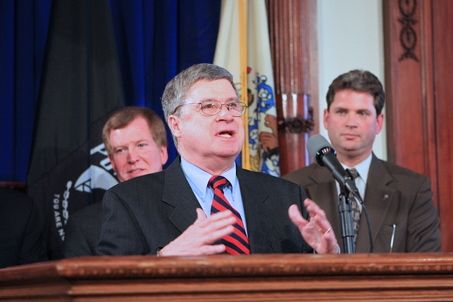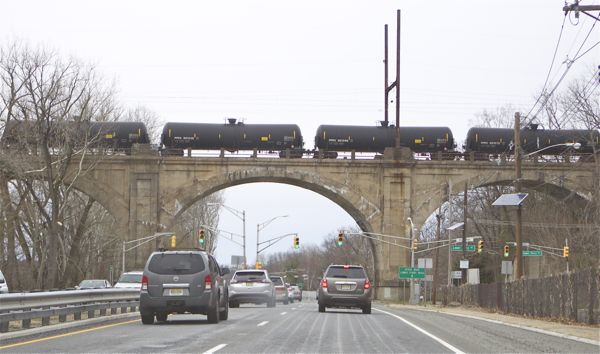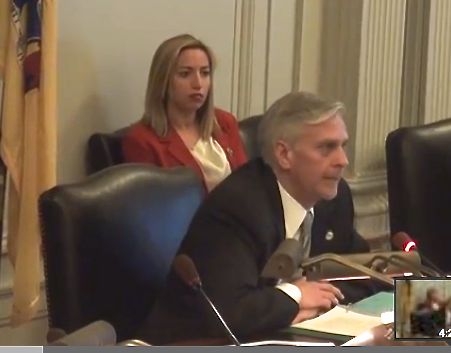NJ Audubon Supported Preservation of Highlands Forests, Not Logging – What Explains The U-Turn?
NJ Audubon Head Eric Stiles Has Some ‘Splainin’ To Do
Aggressive Defense of Controversial Sparta Mt. Logging Plan Shreds Group’s Credibility
Forest wildlife diversity depends on large contiguous forest patches, connections to other habitats, structurally complex vegetation, intact seasonal wetlands, and the presence of native vegetation. Disruption of any of these components can dramatically reduce wildlife diversity. ~~~ Eric Stiles, NJ Audubon (“State of the Forest” Symposium (2002))
Eric Stiles, current President of NJ Audubon, was once a long time and leading advocate of preservation of Highlands forests, not logging them.
Yet now, at a time when he heads the organization, NJ Audubon is advocating exactly the opposite Highlands forest management policy and conservation strategy.
What explains the radical 180 degree U-Turn?

Tom Gilmore speaks in Governor’s Office, when Corzine signed legislation establishing a moratorium on the harvest of horseshoe crabs. (March 2008)
In 2004, as a consultant to the NJ Highlands Coalition, just after passage of the Highlands Act, I worked closely with Eric Stiles in working with DEP in crafting the DEP regulations to implement the Highlands Act’s protections.
At that time, Stiles served as Vice President, Conservation and Stewardship, under the universally well respected and effective leadership of now retired President Tom Gilmore.
Stiles was responsible for forest metrics. He strongly advocated the position that the primary forest management objectives were to:
- preserve the few remaining large blocks of intact contiguous forest
- stop fragmentation and disturbance, especially on steep slopes
- maximize canopy cover
- preserve existing vegetation, especially riparian and wetlands
- minimize creation of new forest edge
- protect habitat of scores of species of threatened interior forest birds, and
- prevent sunlight from the forest floor which fueled invasive species and deer browse
I recently was told by a leading professional ecologist that Stiles did his Masters thesis on these same forest metrics.
The US Forest Service, upon whose work the Highlands Act was based, shared very similar concerns:
-
The Highlands serve as a major migratory flyway for many neotropical bird species, many of which populations are in decline. Of particular concern to ornithologists are the 70 to 75 species of interior nesting neotropical migrants such as the red-eyed vireo, American redstart, Kentucky warbler, and eastern pewee. These species require large undisturbed forest patches.
Fragmentation and alteration of habitat continue to pose the greatest threat to the biological communities in the Highlands. The rapid expansion of urbanization encroaches on and fragments habitat, destroys individuals as well as populations, and potentially threatens the continued existence of many biological communities. Degradation of habitat by direct destruction or indirectly through pollution,erosion, introduction of invasive species, or fragmentation threatens the existence of species, diminishes natural communities, and reduces genetic variability. ~~~ NJ/NJ Highlands Regional Study (US Forest Service, 2002)
But now, a decade later, NJ Audubon is advocating EXACTLY THE OPPOSITE forest management and conservation strategy.
They seek to create young “early successional forest” by logging large blocks of contiguous forest and “mimicking” utility line ROW clearcuts in the heart of the interior forest.
Their “forest stewardship” model will increase fragmentation by roads and logging operations, create huge disturbance of soils and vegetation, reduce canopy cover, increase sunlight and invasive species, and expand forest edge and damaging deer browse. It is targeted not at scores of rare and threatened interior bird species, but a single species, the Golden Wing Warbler that requires scrub/shrub habitat.
But you don’t have to take my word for it that Stiles advocated preservation of Highlands forests based on these specific metrics.
Even prior to my work with Stiles in 2004, back in 2002, Stiles delivered a paper at a “State of the Forest” symposium sponsored by, among others, NJ Audubon.
Stiles’ paper was titled: Impacts of Ecosystem Degradation on Forest Wildlife Diversity and here’s what he wrote:
Forest wildlife diversity depends on large contiguous forest patches, connections to other habitats, structurally complex vegetation, intact seasonal wetlands, and the presence of native vegetation. Disruption of any of these components can dramatically reduce wildlife diversity. Ecosystem degradation affects all of these factors.
A healthy ecosystem results from a complex mix of decomposition cycles, nutrient circulation, soil systems, hydrology, and energy flow. Each of these processes may be analyzed at the smallest (chemical) level or on a grander scale, encompassing physiographic areas. Regardless of scale, we can trace current ecological degradation to several long- and short-term human- induced mechanisms of change.
One of the most devastating causes of ecological degradation is fragmentation resulting from new developments and roads. The results of development are known to anyone with a backyard, but they should still be documented. Fragmented forest and wetland habitats have more predation, more parasitism, and less vertebrate diversity than intact habitats. Overall, the productivity and ecological stability of the land suffers significantly. Edge effects from development and roads are not restricted to areas immediately adjacent to the edge. Overhead pictures of roadways show that visible forest degradation extends for 600 meters from the borders of major roads.
Roadways and other impervious surfaces that go along with development produce dramatically increased water runoff. Increases in impervious surfaces ? now 10% of New Jersey land ? have resulted in erosion and flooding that eliminate vernal pools and species reliant on them. Less directly, flash floods remove food sources and nutrients from the water and correspond with decreasing groundwater recharge. Less water feeds streams, lakes, vernal pools and vegetation. Parched ground increases plant mortality, decreases plant diversity, and further impacts the ecological cycle.
Runoff from developed areas also carries contaminants into neighboring ecosystems. These substances, combined with larger-scale air and water pollution, heavily impact native plants and animals, leading to a further reduction in diversity.
Native plants and wildlife suffer additional damage from invasive species.
(hit the link above to read Stiles complete paper and the entire symposium)
Now Stiles is advocating exactly the opposite.
Maybe this U-urn has something to do with the need to generate funds to pay the salaries of his 10 member forrest logging staffers?
Rapid growth in Audubon’s staff and budget was touted as a major accomplishment when Stiles was named successor to Tom Gilmore: (Audubon press release)
Stiles came to New Jersey Audubon in January of 2002 to serve as Vice president for Conservation and Stewardship. Stiles grew his department from a staff of 1 and a budget of less than $100,000 to a staff of 8 and a budget in excess of $1,000,000.
The question is, what is Stiles willing to do to continue that growth in budget and staff? (and collect that $102,000+ salary)
From 2011 to the present, the NJ Audubon Society supported legislation to create a Forest Stewardship program on public lands exactly like the controversial logging program they are trying to accomplish on Sparta Mountain.
We must recall that Audubon’s “stewardship” model was opposed by most NJ environmental groups and many people contacted legislators to support preservation of NJ’s forested public lands.
At least 38 ecologists and scientists opposed NJ Audubon’s model – Audubon was virtually alone, supported essentially only by special interests groups that would economically benefit from logging forests.
Not surprisingly, NJ Audubon lost that legislative debate.
Now, after losing the debate, they are working behind the scenes with professional foresters and DEP to achieve unilaterally what they failed to get enacted into law.
They will be stopped again by public opposition of those who love and want to preserve NJ’s last remaining forested public lands, acquired with public funds.
In our next post, we will provide the letters and arguments of those 38 scientists who opposed NJ Audubon’s version of “Forest Stewardship”.

